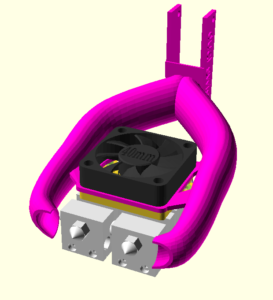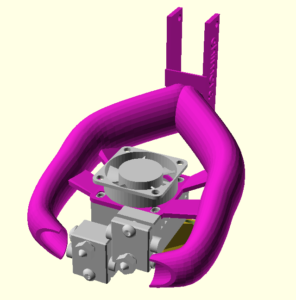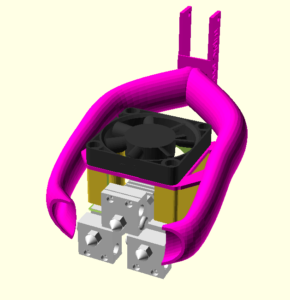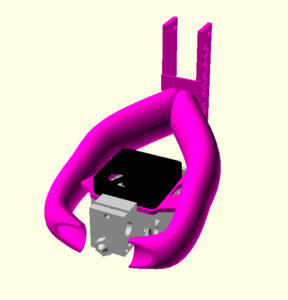The past year (2018/2019) I printed with my own designed 3D Printers with various printheads and required for each variant a dedicated Part Cooler, and I realized it was worth the time to approach this in a parametric manner using OpenSCAD, using the “bull horn” design and so I came up with a general approach, and as a result was able to create various variants for my use-cases:

- Custom Triple (& Dual) Micro Swiss hotends (3 nozzles, 3 heatsinks)
- Chimera 2-in-2 (2 nozzles, 1 heatsink)
- Cyclops NF 2-in-1 (2 intake, 1 nozzle, 1 heatsink, non-mixing)
- E3D Volcano (1 nozzle, 1 heatsink, large nozzle diameter)
- E3D V6 Lite (1 nozzle, 1 heatsink, small / medium nozzle diameter)
- a few other specialized setups
- Dual Micro Swiss
- Dual E3D V6 Lite
- Triple Micro Swiss
- Single E3D V6 Lite
Needless to say, the proven design allowed me to quickly design and print a new variant, and have expected results when using the part cooler – which is a huge time saver.
Yet, one drawback is obvious: in order to adapt a new variant, one requires the surrounding parts like heat sink and nozzle as a model or design it yourself (which can be time consuming as well) so the proper variables can be found to render the part cooler for the setup.
After I designed my 3D Printers also in parametric manner, like the Ashtar K (Prusa i3-like) 380x300x300mm build volume or Ashtar C (Core XY) 380x400x380mm build volume, using this parametric approach for a Part Cooler as well, turned out quite successful too.
It makes sense to develop and design a parametric piece which
- maintains a few constraints, a general form, a base functionality
- requires a few variables to adapt certain customization, sometimes it makes sense to introduce a lot of variables, and while testing and adapting customized pieces, some variables may become constants and unforeseen variables become more important
It certainly requires expertise about the piece in order to discern the constraints from the variable aspects while still maintaining its base functionality.
That’s it.
PS: See Parametric Part Cooler project page for new developments.




